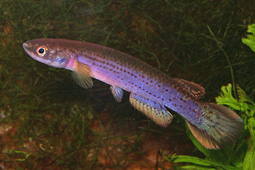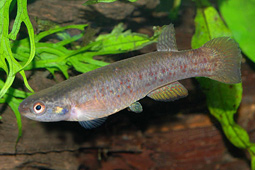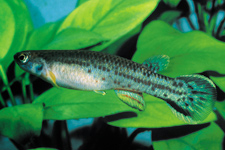History
Alternative name Cynodonichthys brunneus.
Type locality of Rivulus brunneus is situated at Toro Point, Canal Zone, Atlantic side, Panama.
On 25 January 1912 Meek and Hildebrand discovered the species themselves. The name refers to the dark brown basic colour of the body. (Latin: brunneus = dark brown.)
Rivulus brunneus is only known from the type area and is biogeographically replaced by Rivulus montium in the east, Rivulus villwocki in the south and Rivulus of unknown type in the west. It can be found sympatric with Rivulus chucunaque or Rivulus weberi.
Reproduction
Keeping and breeding is easy but a tight fitting cover on the aquarium is necessary because their ability to jump, even through the smallest opening, is unbelievable.
This species can, if there is enough space for them, be housed in a tank with more than one male and several females. If separated before and brought together again however, they can be very aggressive towards each other and fight to become the dominant fish. The best way to produce numbers of fry is to put a pair or a trio in a small tank of about 10 litres with a small filter in it or with some aeration. On the bottom of the tank place some peat moss or dark gravel and a floating "mop" to give space for laying their eggs. The fish will, if they are fed a rich variety of live food, spawn during their whole adult life and produce daily between 5 to 15 eggs.
The eggs should be collected by hand and stored for about 14 days in a small container. Eggs are 1.6 mm and amber coloured. It is wise to add an anti fungus to the water you store the eggs in, to prevent fungal attacks.
After hatching the young fry can eat fresh artemia nauplii without any problem. It takes 4 to 5 months to raise them to maturity. Often the number of males far outweighs the number of females. For some species this can become a major problem for the breeder, as he has to raise many fry to be able to distribute a few pairs to other hobbyists. Recent personal tests found that lower pH levels during the incubation period gave higher percentages of females. To achieve this I used some peat moss that I added to the container with the eggs just before they are ready to hatch. This peat moss also is a good way to prevent eggs being attacked by fungus.
Their lifespan can be up to 3 years in captivity.
Remarks :
Variations
Map
Meristics
Max. size 6.0 cm.
Dorsal 9.3,
Anal 13.8,
D/A 10.1
LL scale count (average)36.1
Pre- dorsal length to % SL – 75.2 %
Depth to % SL – 18.7 %
Literature
Meek, S.E. & S. F. Hildebrand. 1913. New Species of Fishes from Panama. Fie;d Columbian Mus. Zool. Ser. (Chicago Nat. Hist. Mus. Fieldiana Zool.) Publication, 166, 10 (8): 86.


